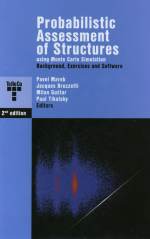 |
Probabilistic Assessment of Structures using Monte Carlo Simulation.
Background, Exercises and Software.
Second extended edition.
Pavel Marek, Jacques Brozzetti, Milan Guštar and Paul Tikalsky, editors.
Publisher: Institute of Theoretical and Applied Mechanics,Academy of Sciences of Czech Republic, Prosecká 76, 190 00 Prague 9, Czech Republic.
© 2003
ISBN 80-86246-19-1.
|
|